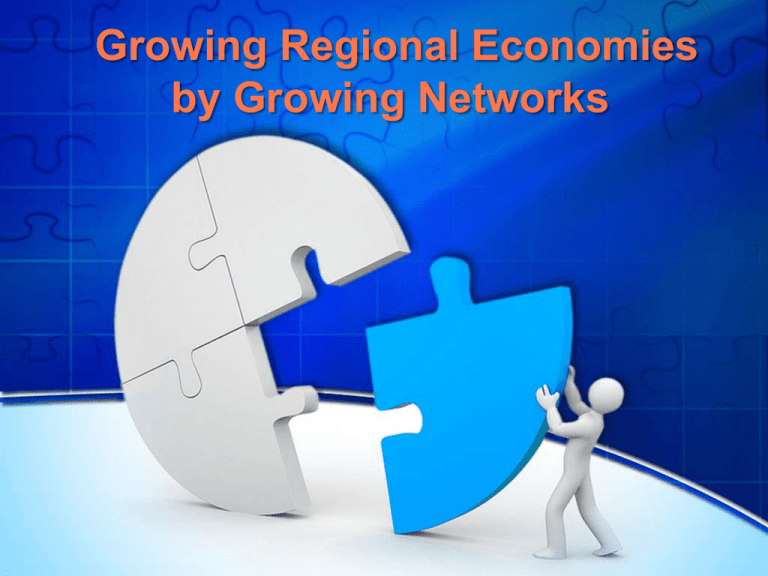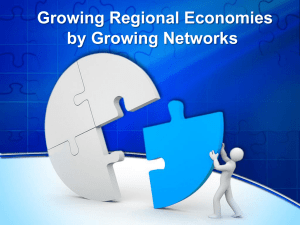Networks - PowerPoint presentation
advertisement

Growing Regional Economies by Growing Networks Overview • How networks accomplish complex work • Networks supporting economic development Entrepreneurship Industry Occupational Civic • Strategies for starting and growing networks It’s a Small World…After All! Everybody has a “small world” story. What’s yours?? Connections • We live in a world of connections. • Opportunities emerge when we create & nurture new connections & leverage them to create new value. • We call these collections of deliberate connections networks. Networks Has your personal or professional network added value (economic, social, etc.) to your life by: Helping you find your current job? Providing information when you needed it? Helping you buy or sell something? Improving organization to produce change? Networks Can Accomplish Today’s Complex Tasks 1928: < 60; all Warner Brothers 2011: >1,750; hardly any WB 6 From Tight Hierarchies to Open Networks Components of a Network Assets People Groups Organizations Objects Links Relationships Transactions Flows When assets get connected in a network, they can become more valuable than the sum of their parts. Networks in Economic Development Industry Occupational Entrepreneurship Civic Industry & Occupational Networks Network = Cluster Four phases of industry & occupational network/cluster development: 1. 2. 3. 4. Articulation Activation Acceleration Assessment Occupational Networks Case Study – Launching new enterprises through occupational networks Activity: Identify the four phases of industry & occupational network development in this example. Entrepreneurship Networks • • • • • Peer learning occurs Resources are shared New ventures are explored Pitfalls are avoided Needs are aggregated Entrepreneurship Network Case Study ACEnet provides a wide range of assistance to food, wood, and technology entrepreneurs in 29 counties of Appalachian Ohio. ACEnet: Scattered Fragments Began weaving the network by asking questions: • From whom do you get new ideas that benefit your work? • From whom do you access expertise that improves your operations? • With whom do you collaborate? Scattered Fragments Network Creating a Network Hub Kitchen incubator became a hub for restaurateurs and farmers Hub-&-Spokes Network Emerged Creating Multiple Hubs • Farmers market • Outdoor café • Restaurant association Multi-Hub Network Expanding Network Boundaries Developed the Appalachian Ohio Regional Investment Coalition to bring in additional resources Core & Periphery Network The Appalachian Ohio “Salsa” Cluster • 20+ boutique salsa businesses in region • $700K annual sales among new businesses • 350 gallons and 445 lbs of fresh and preserved foods delivered to the region’s food pantries annually • ACEnet serves over 200 existing and emerging entrepreneurs each year Four Phases of Network Development 1. Scattered Fragments 2. Single Hub-and-Spoke 3. Multi-Hub 4. Core/Periphery Civic Network Continuum Trust CoCreation CoExecution Turf Sharing Resources Sharing Information Mutual Awareness Acknowledging Exploring Cooperating Collaborating Innovating TIME You have to walk before you run Adapted from Collaboration Continuum from ACT for Youth Adapted from Collaboration Continuum from ACT for Youth The Network Leader NEW NETWORK LEADER ROLE RESPONSIBILITIES Convener Maintains civic spaces Connector Links people and other assets Civic Entrepreneur Sees new opportunities Guide Maps a complex process Strategist Reveals larger patterns Distills face-to-face conversations into key points and patterns Applies Web 2.0 power tools Knowledge Keeper Web 2.0 Maven Seven Levels of Network Weaving 1. Introducing A and B in person and offering a collaboration opportunity to get A and B started in a successful partnership 2. Introducing A and B in person and then contacting A and B afterward to nurture the connection 3. Introducing A and B in person 4. Hosting a conference call introduction of A and B 5. Sending an email introduction of A and B 6. Suggesting to A that A should talk with B and then contacting B to let B know to expect a call from A 7. Suggesting to A that A should talk to B Summary • Networks can help accomplish complex work. • Specific networks help support economic development: Entrepreneurship Industry & Occupational Civic • Specific roles and skills create and grow networks. Final Reflections Takeaways from this module? What did you find most helpful? What did you find confusing? What do you hope to implement? Other items?


